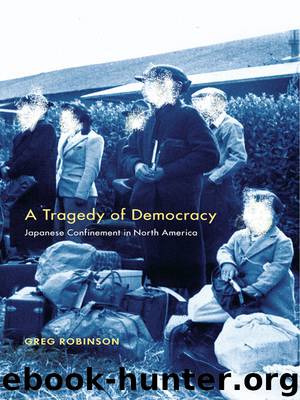A Tragedy of Democracy by Greg Robinson

Author:Greg Robinson
Language: eng
Format: epub
Tags: History/United States/20th Century
Publisher: Columbia University Press
Published: 2011-12-23T16:00:00+00:00
ANGLER CAMP
The “troublemakers” among Japanese Canadians were interned by the government in Angler, Ontario (some were held first at Petawawa). The origins of these 750-odd Issei and Nisei men, and the cause of their being sent to Ontario, varied considerably. Some were Issei who had been taken into custody as potential dangerous in the wake of Pearl Harbor. Others were members of the Nisei Mass Evacuation Group who had resisted going to road work camps or requested internment during the Hastings Park period. Others had been arrested for being recalcitrant. For example, two men working at a road labor camp in Alberta who refused to work after their crew members were injured by falling rocks were taken into custody and sent to the POW camp.124 Takeo Nakano, an Issei from Woodfibre, had a particularly tragic tale. After being released from a road camp, he had gone to rejoin his family. When he reached the “ghost towns,” however, he was assigned to live in the Slocan camp, where authorities claimed they had need of workers. Nakano protested, saying that he had been promised he could join his family in Greenwood. When he was sent to Slocan nevertheless, he and fourteen colleagues refused to work unless they were reunited with their families. All were summarily taken way, sent to jail in Vancouver, and removed from there to Angler.125
If these men’s origins were diverse, they were given largely identical treatment. The camp was surrounded by armed guards and barbed wire fences. In a powerful demonstration of official terror, as part of the clothing they were issued, each inmate received a uniform with a large red circle on the back, resembling the rising Sun on the Japanese flag. While this was supposedly to identify them more easily in case of escape, the prisoners were conscious of the resemblance of the marker to a bull’s-eye, which seemed to invite prison guards to shoot them in the back. Indeed, in July 1942 guards actually shot bullets into the huts at Petawawa, forcing inmates to seek cover. Confined to a small area and separated from their families, the inmates were housed in unpartitioned bunks in four double-winged huts constructed of tarpaper-covered wood, where they struggled against the lack of privacy and the frigid winter weather. Their sending of mail was limited to four postcards plus small letter sheets per month, and the contents were censored. There was little available to them in the way of libraries or school facilities, although the Red Cross donated some books, cigarettes, and recreational equipment, and a recreation hall was eventually opened to provide movies, music practice, and judo instruction. In theory, these internees (uniquely among confined Japanese Canadians) were not required to be self-supporting, but were guaranteed minimum support by the Geneva Convention. They also received a monthly allotment of fifty dollars through the Spanish consul (according to one source, from his own pocket), plus food packages and aid from inmates in the “ghost towns.”126 However, because of supply problems, as
Download
This site does not store any files on its server. We only index and link to content provided by other sites. Please contact the content providers to delete copyright contents if any and email us, we'll remove relevant links or contents immediately.
| Arms Control | Diplomacy |
| Security | Trades & Tariffs |
| Treaties | African |
| Asian | Australian & Oceanian |
| Canadian | Caribbean & Latin American |
| European | Middle Eastern |
| Russian & Former Soviet Union |
The Secret History by Donna Tartt(16635)
The Social Justice Warrior Handbook by Lisa De Pasquale(11490)
Thirteen Reasons Why by Jay Asher(7793)
This Is How You Lose Her by Junot Diaz(5777)
Weapons of Math Destruction by Cathy O'Neil(5039)
Zero to One by Peter Thiel(4828)
The Myth of the Strong Leader by Archie Brown(4790)
Promise Me, Dad by Joe Biden(4451)
Beartown by Fredrik Backman(4421)
Stone's Rules by Roger Stone(4418)
How Democracies Die by Steven Levitsky & Daniel Ziblatt(4401)
The Fire Next Time by James Baldwin(4345)
100 Deadly Skills by Clint Emerson(4080)
A Higher Loyalty: Truth, Lies, and Leadership by James Comey(4034)
Rise and Kill First by Ronen Bergman(4013)
The David Icke Guide to the Global Conspiracy (and how to end it) by David Icke(3884)
The Farm by Tom Rob Smith(3873)
Secrecy World by Jake Bernstein(3784)
The Doomsday Machine by Daniel Ellsberg(3733)
